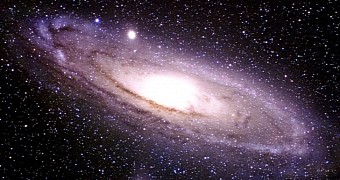As it turns out, there is one very good reason why massive galaxies are sometimes referred to as space monsters: they have cannibalistic tendencies, meaning that they are anything but shy about feasting on smaller galaxies in their proximity.
Even more shocking, researchers with the University of Western Australia say that our home galaxy, the Milky Way, is on the verge of turning into a cosmic cannibal and joining the pack of space monsters that grow by eating their feeble neighbors.
Massive galaxies are surprisingly vicious
In a paper published in today's issue of the journal Monthly Notices of the Royal Astronomical Society, University of Western Australia scientists argue that, according to evidence at hand, monster galaxies behave differently than smaller ones.
More precisely, the astronomers say that, having studied about 22,000 galaxies, they found that those that are not all that impressive size-wise are surprisingly efficient at turning gas in their entrails into new stars, Phys Org informs.
Massive galaxies, on the other hand, appear to be quite lazy, meaning that they prefer to grow by snacking on their smaller neighbors. In doing so, they become foster moms for the stars that the smaller galaxies spent millennia on end birthing.
“All galaxies start off small and grow by collecting gas and quite efficiently turning it into stars,” Dr. Aaron Robotham said in a statement. “Then every now and then they get completely cannibalized by some much larger galaxy,” the researcher further explained.
Scientists expect that, in time, monster galaxies' appetite for their neighbors will translate into the universe coming to comprise just a few freakishly massive galaxies. However, it will be several billion years until this happens, which means that, unless the fountain of youth really exists, we won't be around to see this happen.
What the future has in store for our Milky Way
As mentioned, our home galaxy is slowly turning into a cosmic cannibal itself. Thus, scientists say that the Milky Way appears to be gradually moving from growing mainly by creating new stars to getting bigger chiefly by engulfing other galaxies in its proximity.
In fact, evidence at hand indicates that the Milky Way has already snaked on a few other galaxies, and plans to do it again sometime in the future. More precisely, it is expected to eat two nearby dwarf galaxies, the Large and Small Magellanic Clouds, in about 4 billion years' time. One billion years later, it will merge with nearby Andromeda Galaxy.

 14 DAY TRIAL //
14 DAY TRIAL //